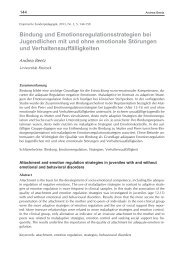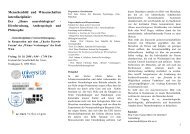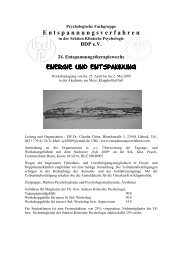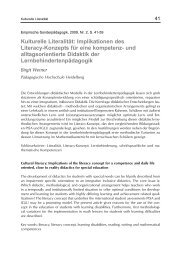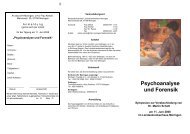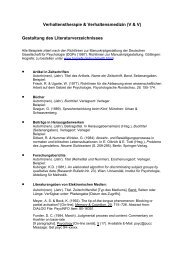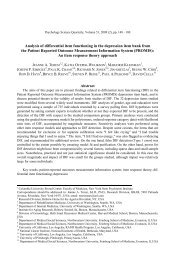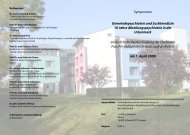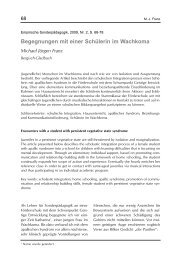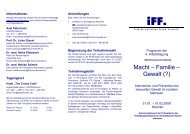Scale construction and evaluation in practice: A review of factor ...
Scale construction and evaluation in practice: A review of factor ...
Scale construction and evaluation in practice: A review of factor ...
You also want an ePaper? Increase the reach of your titles
YUMPU automatically turns print PDFs into web optimized ePapers that Google loves.
<strong>Scale</strong> <strong>construction</strong> <strong>and</strong> <strong>evaluation</strong> <strong>in</strong> <strong>practice</strong> 283<br />
analyz<strong>in</strong>g these matrices, as ML is known to produce erroneous st<strong>and</strong>ard error estimates<br />
<strong>and</strong> χ 2 -based fit measures when applied to correlation matrices (see, e.g., Cudeck, 1989).<br />
In 10 studies, it is unclear what matrix is used for the analysis, which is certa<strong>in</strong>ly not a<br />
good report<strong>in</strong>g <strong>practice</strong>. In one <strong>of</strong> the 20 studies where EFA is applied, polychoric correlations<br />
are analyzed. The other EFA studies either use product-moment correlations or<br />
provide no <strong>in</strong>formation, which probably also <strong>in</strong>dicates the use <strong>of</strong> product-moment correlations.<br />
Peculiarities<br />
When model assumptions are violated, an analysis may produce unexpected results.<br />
Peculiar results may also occur due to other problems, such as model underidentification.<br />
Remarkably, none <strong>of</strong> the studies report peculiarities such as nonconvergence<br />
<strong>of</strong> the estimation procedure or the occurrence <strong>of</strong> Heywood cases. It is, however,<br />
strongly recommended (e.g., B<strong>and</strong>alos & F<strong>in</strong>ney, 2010; Boomsma, 2000; De Ayala,<br />
2010) to pay attention to unexpected features <strong>of</strong> an analysis first, before perform<strong>in</strong>g any<br />
other <strong>evaluation</strong> <strong>of</strong> the results <strong>of</strong> that analysis. If no peculiarities are encountered, one<br />
should also report this fact.<br />
The lack <strong>of</strong> reported peculiarities could be expla<strong>in</strong>ed <strong>in</strong> a number <strong>of</strong> ways. Researchers<br />
could fail to notice peculiar outcomes; or would prefer not to report them, because they<br />
th<strong>in</strong>k that journal editors might not be <strong>in</strong>cl<strong>in</strong>ed to accept papers <strong>in</strong>clud<strong>in</strong>g studies with<br />
peculiarities (cf. the “file-drawer” problem; Scargle, 2000).<br />
Model fit <strong>and</strong> modification<br />
In 26 <strong>of</strong> the studies, CFA is part <strong>of</strong> the analysis. Model fit is formally tested <strong>in</strong> all <strong>of</strong><br />
these, except for one (Arr<strong>in</strong>dell et al., 2005), where the multiple group method<br />
(Holz<strong>in</strong>ger, 1944) is applied, for which no formal test <strong>of</strong> model fit exists. The measures<br />
most <strong>of</strong>ten reported for exam<strong>in</strong><strong>in</strong>g model fit are the root mean square error <strong>of</strong> approximation<br />
(RMSEA), the goodness-<strong>of</strong>-fit <strong>in</strong>dex (GFI), the comparative fit <strong>in</strong>dex (CFI), <strong>and</strong> the<br />
Tucker-Lewis or nonnormed fit <strong>in</strong>dex (TLI or NNFI). Other reported measures are the<br />
(st<strong>and</strong>ardized) root mean residual [(S)RMR], the normed fit <strong>in</strong>dex (NFI), the <strong>in</strong>cremental<br />
fit <strong>in</strong>dex (IFI), <strong>and</strong> the adjusted goodness-<strong>of</strong>-fit <strong>in</strong>dex (AGFI). In addition, the χ 2 test<br />
statistic is usually reported with correspond<strong>in</strong>g degrees <strong>of</strong> freedom <strong>and</strong> p-value, most<br />
<strong>of</strong>ten with the annotation that this fit statistic is very sensitive to sample size. It should be<br />
noted, however, that the χ 2 test statistic is even more sensitive to nonnormality <strong>of</strong> the<br />
observed variables (Boomsma, 1983). When compet<strong>in</strong>g models are compared, reported<br />
measures are the χ 2 difference test, Akaike’s <strong>in</strong>formation criterion (AIC) or a consistent<br />
version <strong>of</strong> the AIC (CAIC), <strong>and</strong> the expected cross-validation <strong>in</strong>dex (ECVI).<br />
Factor load<strong>in</strong>gs are reported <strong>in</strong> 23 <strong>of</strong> the 26 studies that <strong>in</strong>clude a CFA, <strong>and</strong> are discussed<br />
as a criterion for model fit <strong>evaluation</strong> <strong>in</strong> six <strong>of</strong> those studies. The items are then usually



